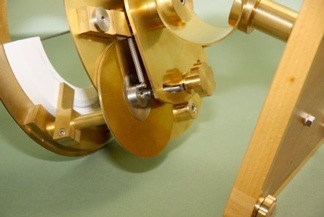

Use in the Southern Hemisphere
Someone in Auckland asked if the Sun Clock could be used in the Southern Hemisphere. I understand from the editor that there are quite a few readers from that part of the world, so I thought it might be useful to share my thoughts with them. I confess that I am not an expert on sundials in the Southern Hemisphere. However, I believe the Sun Clock can be used 'down under', with modification:
1. The Sun Clock is based on an equatorial sundial, and in this type of sundial the gnomon must be set parallel to the earth's rotational axis. Since the dial is set at 90 degrees to the gnomon, the dial lies parallel with the equator. This must be so whether the sundial is intended for the Northern or Southern Hemisphere.
2. In the Southern Hemisphere the sun rises in the east and sets in the west (as in the Northern Hemisphere), but in the Southern Hemisphere the sun travels in the northern region of the sky. This means a sundial's shadow moves anticlockwise. So, unlike a sundial for use in the Northern Hemisphere, in the Southern Hemisphere sundial the hours are labelled increasing in the anticlockwise direction.
3. The equation of time correction value is the same for the Northern or Southern Hemispheres. But now we come to the tricky bit, and that involves the equation of time and the equation of time cam. In the Northern Hemisphere if, say, the uncorrected shadow indicates 12.00 but the true time is 12.15, then the dial has to be turned anticlockwise 15 minutes to correct. Conversely, in the Southern Hemisphere, because the hour labelling increases anticlockwise, the dial has to be turned 15 minutes clockwise to correct. This means that for use in the Southern Hemisphere the amplitude of the equation of time cam is the mirror image of that of the Northern Hemisphere cam (relative to the zero correction radius). The month labelling remains the same.

Another reader contacted me regarding difficulty in obtaining Nitinol (super elastic metal) for the gnomon. You can of course use stainless steel rod instead and some makers have done that. Another alternative is to use stainless steel for the gnomon and spring-load it (a Zebedee gnomon – according to the editor).
Part one here Part two here Part three here Part four here Part five Part six


